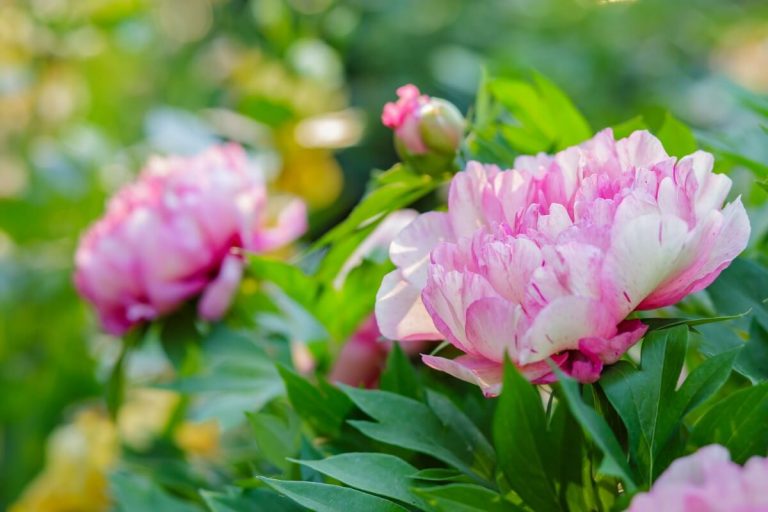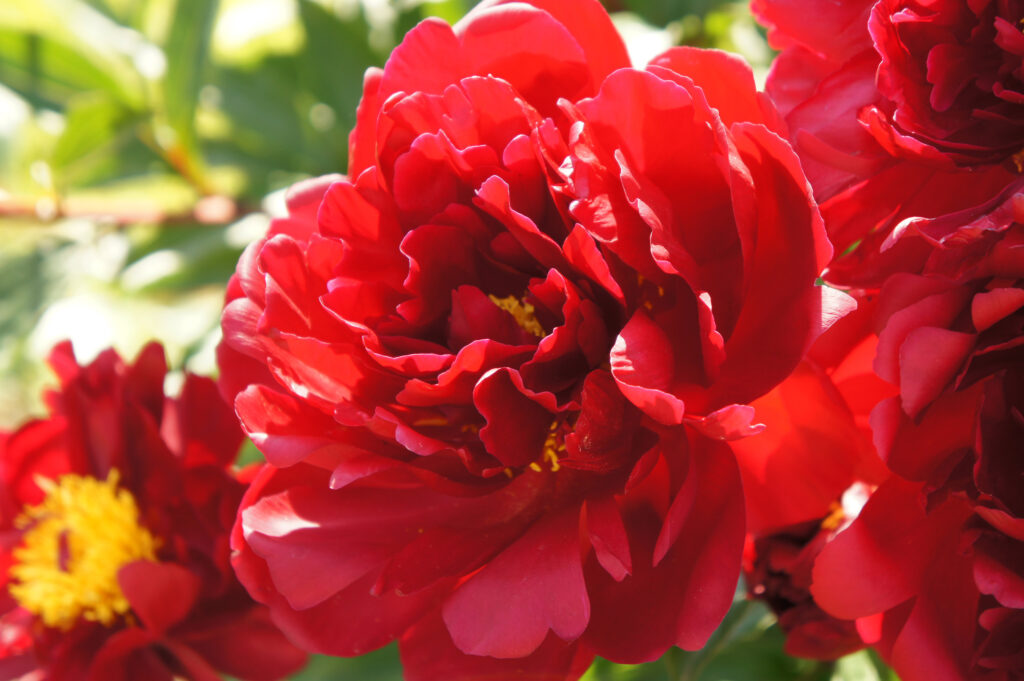Peonies are perennials that come back every year blooming from spring to summer. They are long-lived investments, not to be dealt with haphazardly. Some peonies live over 100 years and are still thriving! Here are a few things you need to pay close attention to growing beautiful peonies.
Peonies are beloved garden flowers that bloom in late spring with huge, lush flowers in shades of pink, red, white and yellow. Getting the most out of your peonies requires understanding their irrigation needs. Knowing how much water peonies need and when to water is key to success.
Water Requirements for Newly Planted Peonies
When you first plant peony roots, generous watering is crucial to establishment and encouraging the roots to grow. Here are some tips
-
New peony roots need about 1 inch of water per week from rain or irrigation the first year. More may be required in hot, dry conditions.
-
Thoroughly water peonies right after planting to remove air pockets and settle the soil
-
Add 2-4 inches of organic mulch around new plants to retain moisture.
-
Check soil moisture daily the first week, then weekly. Insert a finger 1-2 inches down to check.
-
If soil is dry, deeply soak the root zone. Avoid frequent shallow watering.
-
Continue deep weekly watering the entire first year, adjusting for rainfall.
Proper irrigation encourages strong early root growth for new peonies. Once established, they will tolerate some drought.
Mature Peony Water Needs
As peonies mature, their water requirements decrease but regular water is still important, especially during bud set and blooming. Tips for mature plants:
-
Peonies need 1-2 inches of water weekly from rain or irrigation during the growing season.
-
Check soil moisture before watering by inserting a finger 1-2 inches down.
-
Water thoroughly around roots when the top few inches of soil are dry. Avoid frequent light watering.
-
Deeply soak the root zone, then allow it to partially dry before watering again.
-
Increase frequency during bud formation and flowering if rainfall is insufficient.
-
Reduce watering after blooms fade to encourage dormancy in fall.
With proper irrigation, established peonies will thrive and produce abundant blooms for years.
Signs Your Peonies Need Water
In addition to checking soil moisture directly, observe the plants to spot signs of thirst:
-
Wilting or drooping leaves and buds
-
Leaves browning or crisping at the edges
-
Small, lackluster blooms
-
Fewer flowers than normal
-
Stunted or reduced new growth
-
Overall lackluster appearance
If you notice any of these, check soil moisture and water thoroughly if needed. Drought stressed plants are also more disease prone.
Methods for Watering Peonies
Focus watering on deeply soaking the root zone, not frequent light sprinklings. Recommended methods:
-
Soaker or drip hoses at the base to slowly soak the roots.
-
Use a nozzle on a hose to direct water around the plants’ bases.
-
A root fork or soil needle injects water directly into the root zone.
-
Overhead sprinklers for large plantings, watering early so leaves dry quickly.
-
Avoid overhead watering to discourage foliar diseases like botrytis.
Proper peony irrigation provides sufficient moisture while allowing air circulation and dry foliage.
Tips for Watering Peonies
Follow these best practices when irrigating peonies:
-
Check soil moisture before watering to prevent overwatering.
-
Water deeply, then allow the soil to partially dry before repeating.
-
Water early in the day so leaves and flowers dry by night.
-
Avoid getting water on buds and blooms to prevent disease.
-
Increase frequency during critical times like bud set and flowering.
-
Mulch to conserve moisture and suppress weeds.
-
Adjust watering for weather and reduce in fall to encourage dormancy.
-
Group plants with similar needs together for easier irrigation management.
Understanding peonies’ seasonal irrigation needs ensures healthy, thriving plants from planting through years of spectacular blossoms. A little attentive care goes a long way.
Providing peonies with the right amount of water at the proper times encourages strong roots, lush foliage, and the most abundant blooms. Pay attention to their needs through the seasons, and your peonies will flourish and delight you with their spectacular beauty for years to come.

Types of Peonies

Several different types of Peonies are available to grace our gardens and landscapes. Some of the most common garden peonies are Herbaceous, Tree (Woody), or Intersectionals, which are referred to as ‘Itoh’ Peonies after Mr. Toichi Itoh from Japan, who was the first person to successfully cross herbaceous types with tree peonies to create an entirely new group. All types of Peonies are beautiful, easy to grow and care for but all have specific needs and care requirements to help them thrive.
How Much to Water Peonies
The large, brightly toned flowers of peonies are unmistakable. Peonies grow in a variety of soils, but the one thing that can cause root rot is boggy, ill draining soil. This doesnt mean peonies dont need water. On the contrary, these perennial beauties need to be kept moist the first year, and mature plants need supplemental water frequently. Peony water needs depend upon your region but some commonsense info on how to tell when it’s time will keep your plants happy. The peony is native to Europe, Asia and western North America. They grow from thick storage roots that can be divided to create new plants. These roots do not dive deeply into soil. Instead, they are thick branching without many surface roots. Their very structure means they cannot gather moisture from deep in soil nor can they easily harvest dew and lighter moisture at the surface. Peonies are drought tolerant for short periods after establishment but best growth and healthier roots stem from consistent watering. On average, plants need 1 inch (2.5 cm.) of water per week.
How to Water a Peony : Garden Savvy
FAQ
Can peonies be overwatered?
Balance is key when it comes to watering your peonies. Overwatering can lead to root rot, while underwatering stresses the plant. Aim for about 1 inch of water weekly, factoring in both rainfall and manual watering. Use a moisture meter if you’re unsure; it’s a small tool that can prevent big problems.
How often should I water my peonies?
-
New Peonies:Young peonies need more frequent watering, especially in their first year, to help them establish their root system. Aim for deep watering every 7-10 days, says Monrovia.
-
Mature Peonies:Once established, peonies are relatively drought-tolerant but still benefit from consistent watering, especially during dry spells. A good rule of thumb is to water deeply every 10 to 14 days, says Gardening Know How.
-
Watering Frequency in Los Angeles:During the hot, dry summer months in Los Angeles, you may need to increase watering frequency to every week or two, says Monrovia.
-
Checking Soil Moisture:A good way to determine if your peonies need water is to check the soil moisture. If the soil is dry to the second knuckle, it’s time to water, says Gardening Know How.
-
Avoid Overwatering:Peonies do not like wet feet. Ensure your soil is well-drained and avoid overwatering, as it can lead to root rot and other problems, says Peony’s Envy.
-
Watering in Pots:Peonies in pots may need more frequent watering, especially during hot weather, says Brooks Gardens Peonies.
-
Watering after Flowering:It’s important to continue watering peonies after they have bloomed, especially during dry spells, to help them develop strong roots for the following year’s bloom, says Garden Design.
What makes peonies happy?
Peonies perform best when planted in well draining, loamy soil with good air circulation and plenty of sunshine and spring moisture. The best time to divide or transplant peonies is October. This allows plenty of time for root development and nutrient storage before winter.
How do you keep peonies blooming all summer?
Just keep them well-watered during hot weather, apply some mulch at the base of the peonies, apply a balanced fertilizer for flowering plants and avoid disturbance.
How do you care for a peony plant?
Cut off the stems at ground level. Remove the plant debris from the area and destroy it. Proper spacing and watering can help to minimize the severity of the disease. Space peonies 3 to 4 feet apart. When watering is necessary, avoid wetting the peony foliage. Fungicides can be used as a supplement to sanitation and good cultural practices.
How much sunlight do peonies need?
Peonies require about half a day of sunlight daily for consistent growth. They also must be fully exposed to the atmosphere. However, some species, like the Woodland, flourish under filtered sunlight. You can place these in the shadier spots in your garden. Herbaceous hybrids prefer sunnier areas with good air movement.
Do peonies need a lot of water?
Adding a 2- to 3-inch layer of organic mulch in the spring can help conserve soil moisture and gradually adds organic material to the soil as the mulch decomposes. Peonies need only average amounts of water. However, if soil dries out during the hot summer months, they benefit from regular deep watering during these periods.
